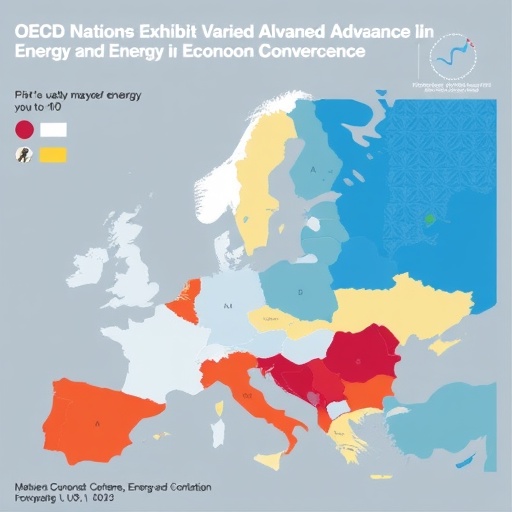In a significant advancement for understanding the complex interplay of economic and energy dynamics within developed nations, recent research has scrutinized the convergence patterns among OECD countries focusing on energy diversification, financial development, and per-capita income growth. The study challenges prevailing assumptions of uniform growth trajectories and highlights the fragmented nature of economic and energy transitions across these influential economies. By employing innovative econometric techniques across a substantial data set from 1997 to 2021, the researchers unravel nuanced convergence phenomena that have critical implications for policymakers, businesses, and international organizations alike.
Divergence, rather than uniform convergence, emerges as the dominant trend among OECD countries when analyzing the intricate relationships between energy diversification, financial development, and income levels. The investigation hinges upon the club convergence framework—an analytical tool that identifies subgroupings or “clubs” of countries sharing similar development trajectories. This approach discerns that while the OECD as a whole does not move harmoniously towards common metrics, distinct clusters exhibit convergence, suggesting that localized or club-specific factors play pivotal roles in shaping these trajectories.
The adoption of Phillips and Sul’s log-t test stands at the core of the methodology, enabling a rigorous detection of convergence clubs over a multi-decade timeline amidst accelerated technological transformation and evolving energy policies. This complex statistical technique allows for differentiation between universal trends and localized convergence behaviors, thereby revealing the multi-speed nature of economic and energy transitions. These results illuminate that countries like Costa Rica, Luxembourg, and Latvia spearhead clusters advancing energy diversification, especially regarding low-carbon energy sources.
Short-term dynamic interactions, probed via Granger causality tests, reveal a web of bi-directional relationships. Specifically, the study identifies that fluctuations in energy diversification and financial development reciprocally influence each other over brief time spans. Such feedback loops accentuate the interconnectedness between financial markets and energy innovation, where investments directed toward renewables dramatically shape and are shaped by evolving financial sophistication and policies within a country.
Long-term analysis, through panel regression models controlling for technological progress, oil price volatility, and human development index variations, establishes technology as a critical driver of progress. Technological advancements elevate per-capita income and catalyze diversification within energy portfolios, effectively acting as a lever to stimulate economic resilience and sustainability. However, this technological edge comes with disparities; wealthier nations pull ahead, harnessing AI-driven energy solutions and expediting renewable energy adoption, while others lag, accentuating financial development divergences within the OECD.
One of the study’s most striking findings is the identification of a U-shaped relationship between per-capita income and energy diversification. Below an annual income threshold approximated at $67,112.80 (2015 USD), wealthier countries paradoxically depend more heavily on fossil fuels, possibly due to entrenched infrastructure or political economy dynamics. Beyond this inflection point, energy diversification accelerates, underpinning a transition to cleaner and more varied energy portfolios. This nuanced insight rebukes simplistic linear assumptions and underscores the complexity inherent in energy-economy interactions.
These observations bear profound practical implications. The fracturing into convergence clubs suggests that sweeping, one-size-fits-all policies risk ineffectiveness. Instead, microeconomic incentives tailored to the technological and financial conditions of each club could promote equitable catch-up within lagging groups. For instance, encouraging the diffusion of clean technologies requires overcoming knowledge and infrastructure gaps that differ substantially between advanced and emerging OECD countries.
Policy frameworks, particularly those aimed at climate and financial reform, must adopt an equity lens. International cooperation in democratizing access to renewable energy technologies and sophisticated financial products emerges as a cornerstone for overcoming observed disparities. The study’s findings support targeted collaboration within convergence clubs to share best practices, optimize resource allocation, and accelerate green transitions in an inclusive manner.
Furthermore, the interplay between financial development and energy diversification reveals intricately linked circular dynamics. Financial markets do not merely respond passively to energy innovation but actively catalyze renewable energy investments by generating capital and offering risk mitigation instruments. This bidirectional causality highlights the crucial role of financial sector reform in energizing sustainability transitions across OECD countries.
Corporate sustainability strategies can leverage these insights to align their ESG reporting and operational standards with club-specific benchmarks, fostering intra-club cooperation and standardization. By integrating convergence trends into their frameworks, businesses can not only improve transparency but also influence policy agendas via demonstrated leadership, echoing the study’s call for coordinated efforts across sectors.
The research also challenges economists and social scientists to incorporate these multi-dimensional convergence metrics into broader developmental theories. Conventional models often neglect energy diversification or treat income and financial development as isolated variables. This comprehensive approach, integrating advanced econometric methods, exposes critical non-linearities and feedback that underpin the evolving economic landscape.
As global economies grapple with the intertwined challenges of climate change and inequality, the study spearheads a paradigm shift, recognizing that convergence within the OECD is neither uniform nor guaranteed. Instead, a mosaic of progress unfolds, shaped by technological innovation, economic structures, policy environments, and financial ecosystems. This revelation propels the discourse beyond simple growth models, orienting scholarly and practical attention towards club-specific strategies that address heterogeneity rather than assuming homogeneity.
In sum, this pioneering analysis of OECD countries elucidates the intricate fabric of economic and energy convergence, revealing pockets of advancement amidst persistent divides. The study’s robust methodology and comprehensive scope open avenues for refined policy design, informed investor strategies, and enriched academic inquiry, charting a path towards a more resilient and sustainable economic future.
Subject of Research: Financial management; Economic development
Article Title: Energy diversification, financial development and economic development: an examination of convergence in OECD countries
News Publication Date: 4-Mar-2025
Web References: http://dx.doi.org/10.1108/CFRI-07-2024-0427
Keywords: Financial management, Economic development




